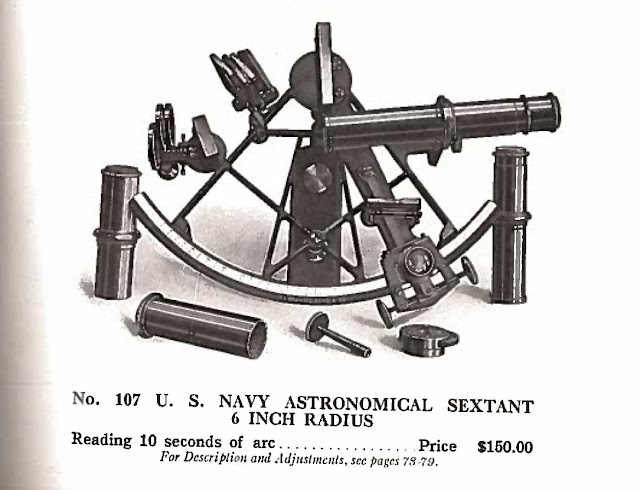A fourth type of sextant that Brandis was making around the time of the first World War was the Astronomical Sextant. As in the last three posts, Brandis Catalog No. 20, published sometime between 1915 and 1917, provides a nice illustration of this sextant type.
The catalog description tells us that these sextants have a 6-inch radius and that they provide a 10-second measurement precision. What stands out to me is the frame pattern, which is quite different and more aesthetically pleasing to my eye than the frame pattern shared by the three sextant types discussed in my earlier posts in this series. Astronomical sextants also appear in the 1895 Brandis catalog, and here we are told that they owe their frame pattern to a Professor Harkness. This must be Professor William Harkness, who among other things was Astronomical Director at the U.S. Naval Observatory and inventor of numerous astronomical instruments [1]. As an aside, the 1895 Brandis catalog refers to the plainer Brandis frame pattern of the other Brandis sextant types we've looked at as the ‘Gambey Pattern', presumably after Henri Prudence Gambey, a French instrument maker of the early 19th century [2]. The Smithsonian has in its collection a 19th century Gambey sextant made for the U.S. Coast and Geodetic Service that looks to be a very close match for a Brandis high grade sextant in terms of its frame pattern and other features [3].
I’ve seen forty-five or so Brandis sextants and not one of them is an astronomical sextant. However, the Smithsonian has two sextants made by Stackpole and Brother (Stackpole #1765 and #2258) that look very much like a Brandis astronomical sextant. An excellent high-resolution photograph of #1765 can be found on the Smithsonian’s website [3]. It may be significant that F.E. Brandis worked for Stackpole and Brother for several years before founding his own instrument company [4].
An unusual feature we can see in both Brandis catalog illustrations and in the photo of Stackpole #1765 (the photo of #2258 is too poorly resolved to tell) is that these sextants have a bubble level attached to their index arms. A bubble level attached to a sextant’s index arm wouldn’t allow a user to hold the sextant level in the absence of a visible horizon as in a Byrd sextant, so what purpose these levels serve eludes me. The description of Stackpole #1765 at the Smithsonian’s website has this to say about the level: “The sextant also has a small bubble level on the index arm. William Harkness, the American astronomer who introduced this feature, said that it "proved a very great convenience and saved much time and trouble.” How the index arm level saved time and trouble we are not told, unfortunately. The only other sextant I’ve ever seen with a bubble level on its index arm is a Cary sextant that can be seen on the Tesseract website [5]. The Cary sextant’s bubble level is perpendicular to the long axis of the index arm, while in the case of the Brandis and Stackpole sextants the bubble levels are not perpendicular to that axis.
The first person to explain to me what what function these index arm bubble levels served gets a free lifetime subscription to the Ghost of Gardner blog. The same goes for the first person to find a photo of a surviving Brandis astronomical sextant.
Comments, corrections, additional relevant facts, differing viewpoints, etc.,
are always welcome (no one will be banned, blocked, or castigated for offering differing opinions). Send to gardnersghost@gmail.com
+~+~+~
[1] Harkness' obituary appears in the April 17, 1903 issue of Science, the journal of the American Association for the Advancement of Science. In 1893, Harkness was president of the AAAS. See: https://books.google.com/books?id=HY8CAAAAYAAJ&pg=PA601&dq=william+harkness&hl=en#v=onepage&q=william%20harkness&f=false
[2] http://americanhistory.si.edu/collections/search/object/nmah_1183824
[3] http://amhistory.si.edu/navigation/object.cfm?recordnumber=1183824
[4] http://amhistory.si.edu/navigation/maker.cfm?makerid=35
[5] http://www.etesseract.com/Navigation/Navigation.html

